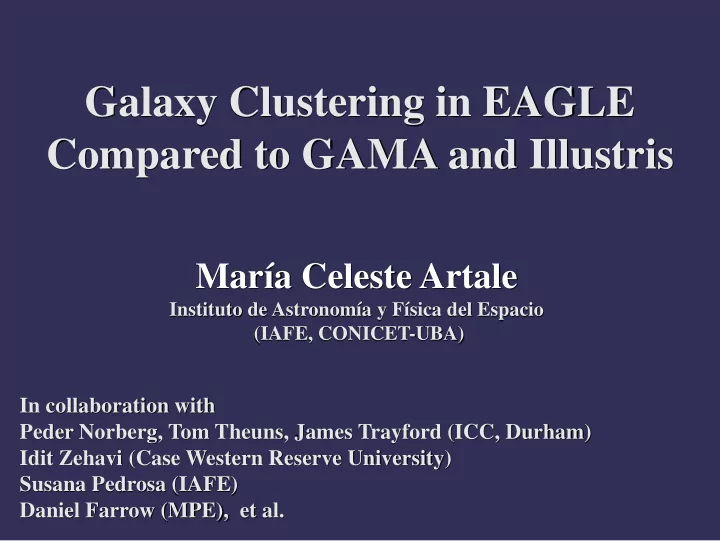

Galaxy Clustering in EAGLE Compared to GAMA and Illustris María Celeste Artale Instituto de Astronomía y Física del Espacio (IAFE, CONICET-UBA) In collaboration with Peder Norberg, Tom Theuns, James Trayford (ICC, Durham) Idit Zehavi (Case Western Reserve University) Susana Pedrosa (IAFE) Daniel Farrow (MPE), et al.
Outline - Motivation - EAGLE simulation and GAMA survey - Data and method - Results - Summary
Motivation - Test whether galaxy clustering within EAGLE and its dependence on galaxy properties is compatible with galaxy clustering from GAMA. - Contrast EAGLE galaxy clustering with other galaxy formation models, e.g. Illustris-1 and GALFORM.
EAGLE Simulation ( Evolution and Assembly of GaLaxies and their Environments) Sub-grid models for: - radiative cooling - star formation - stellar mass loss - metal enrichment - energy feedback from star formation - SMBH - AGN feedback Schaye+2015 * Cosmological parameters from Planck 2013 * We analyze the simulation of 100 Mpc of side * We select galaxy populations by using the EAGLE Database
EAGLE Simulation ( Evolution and Assembly of GaLaxies and their Environments) Stellar feedback and BH accretion → calibrated to match the observed galaxy stellar mass function at z~0 (Baldry+2012)
GAMA Survey ( Galaxy And Mass Assembly) - Spectroscopic and multi-wavelength survey (UV to Far-IR) - Three equatorial fields with a total area of ~180 deg² - Redshift survey to r petro < 19.8 - Highly complete: >98% Farrow+2015 clustering: - Volume and flux limited samples - Our focus: 0.02 < z < 0.14 - Investigate the 2PCF of galaxies as a function of their luminosity, stellar mass and colour
Real space clustering from redshift space π Projected correlation function: (l.o.s.) r r 2 r 1 r p To 0 th order, wp(rp) is well described by a power-law π max → ∞ Zehavi+2011: γ =1.8, r 0 =5.33 h -1 Mpc
Clustering in Dark Matter Halos DM-only simulations Aim: to understand the limitations of using a 100Mpc box z = 0 P-Millennium - Planck 2013 - (800 Mpc) 3 box, i.e. 512x EAGLE ! Illustris-1 Illustris-1 DM-only - WMAP-9 EAGLE DM-only - (106.5 Mpc) 3 box P-Millennium ALL P-Millennium sub-volumes Halos with M 200,c > 10 12 h -1 M ʘ
Clustering in EAGLE Galaxies Fingers-of-God 1-halo term 2-halo term Contours represent ξ = 5, 2, 1, 0.5, 0.2, 0.1, 0.01 Galaxies with log(M * /M ʘ h -2 ) > 8.66
Stellar Mass Dependent Clustering EAGLE GAMA Good agreement between EAGLE and GAMA results
Luminosity Dependent Clustering M r,h from Trayford+2015: - SSP modeling based on GALAXEV of Bruzual & Charlot (2003) - Includes dust absorption (GD+O) - In GAMA data brighter galaxies are more clustered - It is not clear enough in EAGLE results EAGLE GAMA
Color Dependent Clustering M * > 10 8.66 h -2 M ʘ * Colour from Trayford+2015 EAGLE * Red galaxies are more clustered GAMA than blue galaxies * Red galaxies follow the same trend as satellite galaxies * Clustering of EAGLE blue galaxies Green dashed lines: satellite galaxies are in agreement with GAMA Green dotted lines: central galaxies
Color Dependent Clustering * Red galaxies are more clustered than blue galaxies * Red galaxies follow the same trend as satellite galaxies * Clustering of EAGLE blue galaxies are in agreement with GAMA * Clustering of EAGLE red galaxies is not in good agreement with GAMA * Satellite galaxies are strongly clustered than centrals EAGLE GAMA Green dashed lines: satellite galaxies Green dotted lines: central galaxies
Star Formation Rate Dependent Clustering Low SFR population: 30% lowest SFR High SFR population: 30% highest SFR Low SFR: - More clustered in the three stellar mass bins - The most massive DM halos are more populated
Comparison with Other Galaxy Formation Models - Stronger clustering on small scales for Gon14* & Lac14* semi-analytic models. - Illustris-1 shows consistenly a lower clustering amplitude - Galaxies from Illustris-1 reside in less massive halos, compared to EAGLE galaxies
Conclusions * EAGLE galaxy clustering is in good qualitative agreement with GAMA clustering when split by stellar mass or luminosity. * EAGLE red galaxies more strongly clustered than blue * EAGLE red galaxies seem to be more clustered than observations * Low SFR galaxies are more strongly clustered than intermediate and high SFR galaxies * Low SFR galaxies reside in a wide range of DM halo masses * To provide stringent clustering constraints requires significantly larger volumes: typically a (200-300 Mpc/h) 3 box
Recommend
More recommend